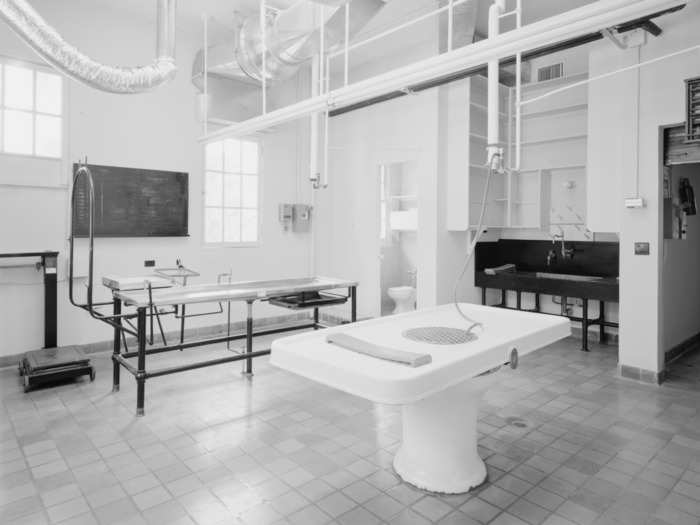
Embalming is the process of pumping a chemical cocktail of formaldehyde, phenol, methanol, and glycerin into the body through an artery to delay the body's rate of decay. This could be used for display purposes during funerals, long-distance transportation, or for use for medical or scientific research. It is also said to give the body a life-like appearance for public viewing.
Formaldehyde is a potential human carcinogen, and can be lethal if a person is exposed to high concentrations. Its fumes can also irritate the eyes, nose, and throat. Phenol, similarly, can irritate or burn the flesh, and is toxic if ingested. Methyl alcohol and glycerin can irritate the eyes, skin, nose, and throat.
According to an article published in the Berkeley Planning Journal, more than 800,000 gallons of formaldehyde are put into the ground along with dead bodies every year in the US. That's enough to fill one and a quarter Olympic-sized swimming pools each year.

According to the Berkeley Planning Journal, conventional burials in the US every year use 30 million board feet of hardwoods, 2,700 tons of copper and bronze, 104,272 tons of steel, and 1,636,000 tons of reinforced concrete.
The amount of casket wood alone is equivalent to about 4 million acres of forest and could build about 4.5 million homes.

After a body is sealed in a hardwood or metal casket, it is often placed in a thin concrete vault, which is then placed in a "memorial park."
These parks generally have sprawling, pristine lawns that require a ton of water, chemical fertilizers, and pesticides to keep them a vibrant green. These chemicals can seep into water supplies or harm wildlife, such as bees.
They also use up a ton of land. If you added up the entire square footage of all the cemeteries in the US, according to Dobscha, it would measure 1 million acres of land.

The cost of an average funeral runs around $10,000, according to the Berkeley Planning Journal. This includes undertaker and cemetery fees, a burial vault, flowers, clothing, transportation, and other related charges.
With nearly 2 million people buried every year, the funeral industry as a whole rakes in about $15 billion a year.

Burning your body into ashes to be kept in an urn or scattered into the ocean instead of a tradition burial is becoming increasingly more common. In fact, more than 50% of Californians prefer cremation to a burial.
While cremation is less harsh on the environment than traditional burial, the process is still noxious. It releases nasty chemicals into the atmosphere, including carbon monoxide, fine soot, sulfur dioxide, heavy metals, and mercury emissions from dental fillings, which are particularly concerning.
In contrast to a natural burial, in which a body is simply left to decompose in nature, cremated ashes are sterile and do not supply nutrients back into the earth.

Greener forms of burial include encasing your body into a pod that eventually sprouts into a tree, or sealing your ashes in a concrete ball that will plunge to the bottom of the ocean to feed coral reefs. These are the best ways to be buried responsibly, Dobscha said.
Other great ways, Dobscha continued, include foregoing embalming, getting buried in a wood-only casket, and using alkaline hydrolysis instead of cremating.
There are also biodegradable casket options, including bamboo, paper, cardboard, wool, banana leaf, and willow.
 Colon cancer rates are rising in young people. If you have two symptoms you should get a colonoscopy, a GI oncologist says.
Colon cancer rates are rising in young people. If you have two symptoms you should get a colonoscopy, a GI oncologist says. I spent $2,000 for 7 nights in a 179-square-foot room on one of the world's largest cruise ships. Take a look inside my cabin.
I spent $2,000 for 7 nights in a 179-square-foot room on one of the world's largest cruise ships. Take a look inside my cabin. An Ambani disruption in OTT: At just ₹1 per day, you can now enjoy ad-free content on JioCinema
An Ambani disruption in OTT: At just ₹1 per day, you can now enjoy ad-free content on JioCinema SC rejects pleas seeking cross-verification of votes cast using EVMs with VVPAT
SC rejects pleas seeking cross-verification of votes cast using EVMs with VVPAT
 Ultraviolette F77 Mach 2 electric sports bike launched in India starting at ₹2.99 lakh
Ultraviolette F77 Mach 2 electric sports bike launched in India starting at ₹2.99 lakh
 Deloitte projects India's FY25 GDP growth at 6.6%
Deloitte projects India's FY25 GDP growth at 6.6%

Copyright © 2024. Times Internet Limited. All rights reserved.For reprint rights. Times Syndication Service.